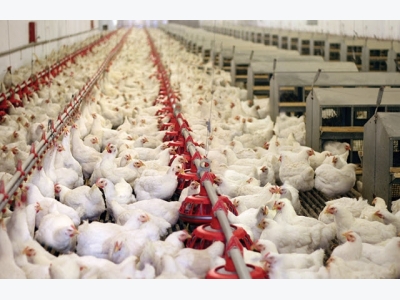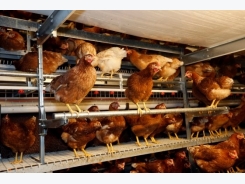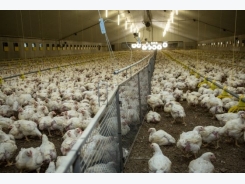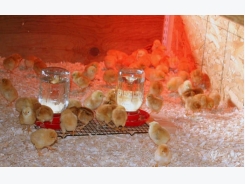Biotin for poultry: An essential but expensive vitamin

Poultry kept on wet litter conditions might require extra biotin supplementation to ensure against leg lesions. | Branex, Dreamstime
Although needed in trivial amounts, biotin plays a significant role in metabolism and affects the cost of vitamin premixes.
For a vitamin that is required at roughly 0.1 mg/kg feed (in a broiler diet, for example), biotin is a significant nutrient in many aspects. Again, the amount required is miniscule: just one tenth of a gram is required per metric ton of complete feed — an amount so small it is difficult to measure without a micro scale.
So, why worry for such a vitamin that can be routinely supplied by any vitamin premix? The reason is cost. Biotin is simply the most expensive vitamin that we use in animal nutrition. When viewed per kilogram of feed, the expense looks ridiculously insignificant to merit spending more time than required to know it is just one more of those vitamins needed by animals. But when one starts making premixes and needs to buy a whole bag or drum of biotin, the expense looks enormous. Pure, d-biotin (the active form) costs up to USD$1,000 per kilogram (depending on volume, origin, purity, etc). In comparison, vitamin E, one of the most expensive vitamins, costs roughly one tenth of the cost of biotin. It suffices to mention here that vitamin E is one of the vitamins most usually limited in cost-sensitive premixes. In other words, one needs to pay close attention to biotin.
The many names of biotin
Biotin was discovered and identified in the decades spanning from the late 1920s to the early 1940s. It was discovered by distinct groups, and in the time between its first discovery and final identification, it took several names, such as vitamin B7, coenzyme R and vitamin H, until the final worker who identified its structure gave it its proper name: biotin.
Most authorities recommend adding a purified source of d-biotin in most poultry feeds through the use of the usual vitamin premix.
Today, biotin is one of the water-soluble vitamins, belonging to the complex of B vitamins, and is recognized as an essential nutrient. The latter means animals require an external supply of this vitamin through their feed. Whether their natural diet contains enough biotin or not is a matter that requires further clarification, which we will discuss later on.
The many functions of biotin
Biotin is required for carbohydrate, lipid and protein metabolism — in essence, a vitamin that works as a cofactor in enzymatic reactions that involve the transfer of carbon dioxide from molecule to molecule. In even simpler terms, it is required everywhere. For those of us who had the misfortune of sitting through nutrition metabolism courses, it suffices to mention two enzymes that haunt every nutrition graduate student: pyruvate carboxylase and acetyl-CoA-carboxylase. It seems a paradox that such important enzymes, on which nutrient metabolism is based, depend on a vitamin that must be consumed daily in such amounts that are hard to measure.
Biotin deficiency symptoms
When biotin is missing, basic metabolism slows down. I believe this is easy to infer from the above. But, in poultry, we have a couple of symptoms that make biotin deficiency easy to detect. The first symptom is dermatitis, or rough and scaly skin, especially around the beak and on the upper surface of the legs. The second symptom in more severe deficiency cases is perosis, a condition that is shared with pantothenic acid deficiency. Perosis is the formation of gross lesions in foot pads that hinder movement. To understand the significance of biotin in good skin condition, it is perhaps interesting to mention that this vitamin is often included in hair and nail care products — for humans, of course. But it is also recommended for farm animals that experience living conditions that reduce the strength of their claws or hooves — such as those standing on wet surfaces.
Biotin and avidin in eggs
Biotin was first discovered in eggs, a rich source of this vitamin, because it was observed that feeding raw egg whites to animals caused symptoms of biotin deficiency. It was then termed the “white egg injury.” As it happens, egg white contains an anti-biotin compound called avidin. This is a glycoprotein that binds biotin, which is located in the yolk, so strongly that it is virtually impossible to reverse this reaction under normal conditions. Why eggs contain avidin is something that escapes scientists at the moment, but it is what it is, and we should consider it if we decide to feed raw egg whites to animals. Heat treatment destroys avidin, releasing biotin, but even then, there is no reason to worry about avidin in whole eggs, raw or processed. The amount of avidin in whole eggs is roughly equimolar to that of biotin. Thus, in the worst-case scenario, egg avidin will just neutralize egg biotin without affecting biotin from other ingredients or premixes.
Which feeds require biotin supplementation?
Cereals like corn and wheat contain about 0.06 and 0.11 mg/kg, respectively. Major protein sources like soybean and rapeseed meals contain 0.26 and 0.98 mg/kg, respectively. In general, cereals are a rather poor sources of biotin, compared to poultry requirements, but they constitute the largest part of their feed (roughly 65 percent). In contrast, protein sources play a small role in terms of inclusion rate (roughly 20 percent), but they are rather good sources of this vitamin. Lamentably, all natural ingredients are characterized by rather poor biotin bioavailability (50 percent), which means about half of natural biotin is of no use to the animal.
A typical diet (corn and soybean meal) will thus contain about 0.09 mg/kg biotin, which is marginal compared to most recommendations. Here, we should mention that the National Research Council (1994)) requirements are between 0.15 and 0.30 mg/kg for the many species and classes of poultry. Thus, it is evident that most natural ingredients will fail to satisfy the total needs of biotin for poultry. In the case of wheat-based diets, this deficiency becomes even more pronounced as wheat biotin is virtually unavailable.
Most authorities recommend adding a purified source of d-biotin in most poultry feeds through the use of the usual vitamin premix. The amount added (without taking into account natural ingredients) is a matter of discussion, because as we have already seen, biotin is very expensive. My personal preference, based on literature review and commercial experience, is adding 0.1 mg/kg biotin in all broiler and layer diets based on corn, and double this amount in diets based on wheat. Perhaps this is an overindulgence, but wet litter is a common problem in broilers and nowadays an ever bigger one with cage-free layers. It is also prudent to review such recommendations when alternative protein sources are used, but again, we have such limited and outdated information on biotin requirements and bioavailability that it is best to err towards the safe side.
Biotin is a significant vitamin
Biotin is a significant vitamin because it holds a central role in nutrient metabolism, but it is only needed in miniscule amounts. Most natural ingredients do not contain enough biotin, and wheat is virtually devoid of bioavailable biotin. Thus, biotin must be supplied through premixes, but its enormous cost warranties vigilance against low-cost products.
About Author: Ioannis Mavromichalis, Ph.D., is an animal nutrition industry consultant
Related news
Tools

Phối trộn thức ăn chăn nuôi

Pha dung dịch thủy canh

Định mức cho tôm ăn

Phối trộn phân bón NPK

Xác định tỷ lệ tôm sống

Chuyển đổi đơn vị phân bón

Xác định công suất sục khí

Chuyển đổi đơn vị tôm

Tính diện tích nhà kính

Tính thể tích ao




 Carcass quality affected by nutrition and management
Carcass quality affected by nutrition and management  How to start your own poultry business
How to start your own poultry business